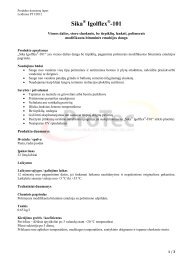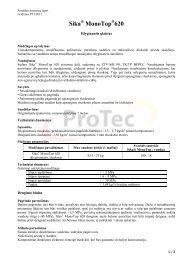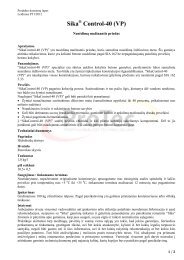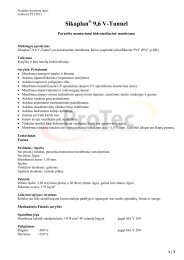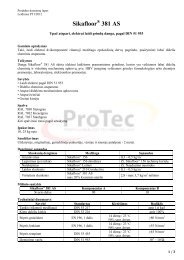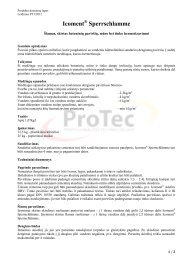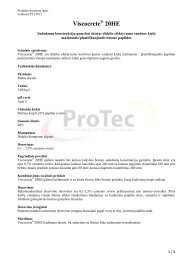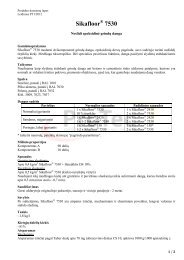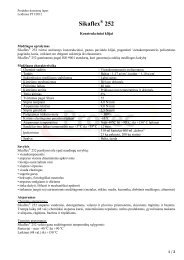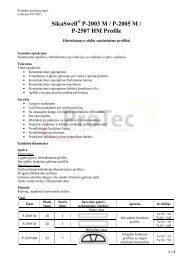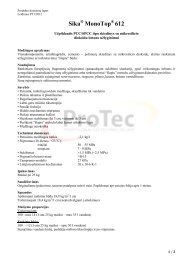Sikaflex Marine Handbook
Sikaflex® Marine Handbook - BlueMoment
Sikaflex® Marine Handbook - BlueMoment
- No tags were found...
Create successful ePaper yourself
Turn your PDF publications into a flip-book with our unique Google optimized e-Paper software.
Instructions ForKeel-to-Hull Joints and SealingDescription of ApplicationThe joint between keel and hull issubjected to very high stresses,particularly when a boat is undersail or if it runs aground.This critical joint must be designedand executed with great care towithstand these stresses.The joint between keel and hull isparticularly prone to leaks, whichmanifest themselves in the form ofrust streaking and staining on thekeel when the boat is removedfrom the water. The use of<strong>Sikaflex</strong> ® in conjunction with themechanical fixings prevents waterpenetration and improves stressdistribution.Preparation of SubstrateAluminium HullsHeavily soiled surfaces should becleaned off first with a pure solvent(Sika ® Remover-208) to remove theworst of the soiling.Lightly abrade contact area with avery fine sanding pad. Remove dustwith a vacuum cleaner.Clean the substrate with Sika ®Cleaner-205, using a clean, lint-free205rag or paper towel. Change ragfrequently!Drying time: minimum 10 minutes,maximum 2 hoursApply a thin, continuous coat of Sika ®Primer-210 T, using a clean brush or210 Tfelt applicator.Drying time: minimum 30 minutes,maximum 24 hoursGRP HullsHeavily soiled surfaces should becleaned off first with a pure solvent(Sika ® Remover-208) to remove theworst of the soiling.Lightly abrade contact area with avery fine sanding pad. Remove dustwith a vacuum cleaner.Clean the substrate with Sika ®205Cleaner-205, using a clean, lint-free206 G+P/215Timber Hulls290 DCrag or paper towel. Change ragfrequently!Drying time: minimum 10 minutes,maximum 2 hoursApply a thin, continuous coat of Sika ®Primer-206 G+P or Sika ® Primer-215,using a clean brush or felt applicator.Drying time: minimum 30 minutes,maximum 24 hoursAbrade contact area on hull withsanding pad (80/100 grit) and removedust with a vacuum cleaner.Apply a thin, continuous coat of Sika ®Primer-290 DC, using a clean brush orfelt applicatorDrying time: minimum 60 minutes,maximum 24 hoursSteel Hulls, Coated with Two-part CorrosionProtection Coating205Clean the substrate with Sika ®Cleaner-205, using a clean, lint-freerag or paper towel. Change ragfrequently!Drying time: minimum 10 minutes,maximum 2 hoursFor the preparation of othersubstrates, please refer to thePrimer Chart.Application of <strong>Sikaflex</strong>®-292 AdhesivePlace elastic spacers in position (thickness 10 mm, approximately 50 Shore A hardness).Fig. AApply <strong>Sikaflex</strong> ® -292 in 20–25 mm high triangular profiles. Each bead must form acontinuous, closed ring, with no gaps. The same applies to the beads around the bolt holes.Important Note: The bond faceon the keel and hull must also bewiped down with Sika ® Cleaner-205. In the case of lead keels, thecontact area must additionally begiven a coat of two-part epoxyresin protective paint.Drying time: 1 day minimum.208The keel is then lifted into position, observing carefully the open time of <strong>Sikaflex</strong> ® -292 andpulled up on the keel bolts as far as the spacer blocks. The adhesive that is squeezed out ofthe joint can be tooled to a smooth finish.After three or four days, the keel bolts can be tightened to their full torque rating. Theadditional pressure thereby exerted on the adhesive, gives the joint between keel and hullthe required degree of torsional stiffness. When the adhesive has fully hardened, the sealedjoint can be overpainted in the normal way with any good quality anti-fouling paint. Thesealed joint absorbs the dynamic stresses generated in this area and forms a totallywatertight bond between keel and hull.Traces of uncured Sika adhesives or sealants may be removed with Sika ® Remover-208.On no account should other cleaning agents or Sika ® Cleaner-205 be used for this purpose.Important: Please refer to the current Sika Technical Data Sheets and Safety Data Sheets obtainable throughSika or their local distributor.15



